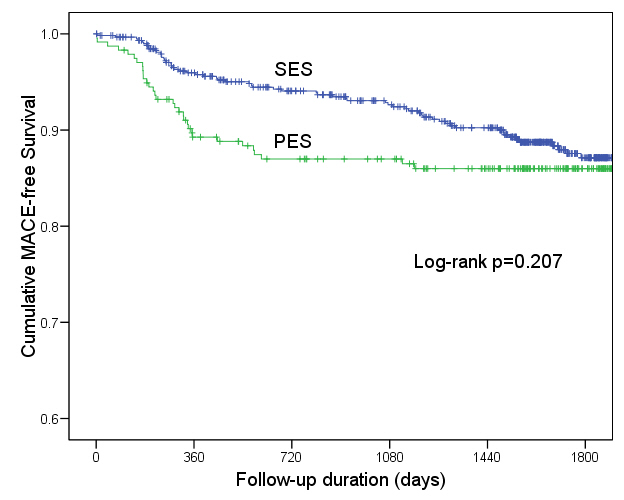| єя«•«ьљƒ : ∆чљЇ≈Ќ±Єњђ
|
ЅҐЉцєш»£ - 530808 13 |
| 5-Year Clinical Outcome after Implantation of Sirolimus–Eluting Stents versus Paclitaxel–Eluting Stents in Unselected Patients with Coronary artery Disease: KOMATE DES Registry |
| мЧ∞мДЄмЭШлМА мДЄлЄМлЮАмК§л≥СмЫР мЛђмЮ•лВік≥Љ¬є, к∞ХлВ®мДЄлЄМлЮАмК§л≥СмЫР мЛђмЮ•лВік≥Љ¬≤ |
| к≥†мШБкµ≠¬є, мµЬнШДнЭђ¬є, л∞ХмГБлѓЉ¬є, кєАм§СмД†¬є, мµЬлПЩнЫИ¬є, нЩНл™ЕкЄ∞¬є, мЮ•мЦСмИШ¬є, лѓЉнХДкЄ∞¬≤, мЬ§мШБмЫР¬≤, нЩНл≤ФкЄ∞¬≤, мЭіл≥СкґМ¬≤, кґМнШБлђЄ¬≤ |
Background: Siroliums-eluting stents (SES) and paclitaxel-eluting stents (PES) have been widely used for the treatment of coronary artery disease. We investigated long-term clinical outcomes of patients (n=955, 669 males, age 61.5±10.1 years) treated with SES versus PES in a multicenter registry. Methods: We compared clinical outcomes of SES (n=671) versus PES (n=284) in an unselected patient population treated from Dec 2002 to Dec 2004. The mean follow-up duration was 49.6±18.5 months. The primary endpoint was the incidence of major adverse cardiac events (MACE) including cardiac death, myocardial infarction (MI), and target vessel revascularization (TVR). Results: Baseline clinical characteristics were similar between the two groups except lesion length (SES: 23.2±7.7 vs. PES: 20.6±7.3 mm, p<0.001) and stented length (SES: 24.9±6.4 vs. PES: 22.58±6.4 mm, p<0.001). At 1 year the MACE occurred in 4.6% of the SES group vs. 10.0% of the PES group (p<0.001). Higher incidence of MACE in the PES group at 1 year was mainly due to higher incidence of TVR (3.5% vs. 8.9%, p<0.001). However, at 5 years the cumulative survival free of MACE in the SES group was 86.2% versus 85.5% in the PES group (Log-rank p=0.207). At 5 years the cumulative rate of TVR was 9.5% in the SES group vs. 11.5% in the PES group (p=NS). Incidence of cardiac death or MI was not different between the two groups. During 5-year follow-up stent thrombosis occurred in 11 patients (1.7%) of the SES group and in 6 patients (2.2%) of the PES group (p=NS). Conclusions: SES showed better clinical outcome at 1 year due to lower incidence of TVR. However, this superiority of SES over PES diminished over 5-year follow-up, because the SES group showed further gradual increase in TVR beyond 1 year whereas PES had a much lesser increase. Therefore, there was no significant difference in the long-term outcome between the two DES types. Our data suggest that late intimal catch-up might play an important role in the long-term result of SES.
|
|
|
Warning: getimagesize(/home/virtual/circulationadmin/renewal/econgress/conference/abstract/img_files/5-yrDESoutcome0.jpg) [function.getimagesize]: failed to open stream: No such file or directory in /home/virtual/circulationadmin/new/econgress/conference/manage/schedule/view_abstract.php on line 164

|
|





